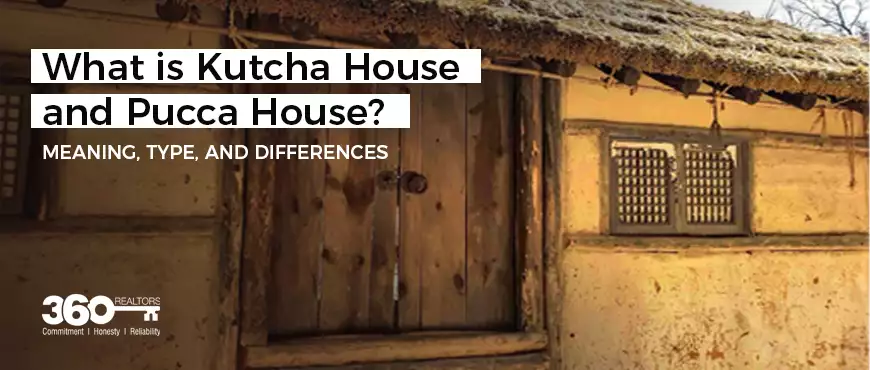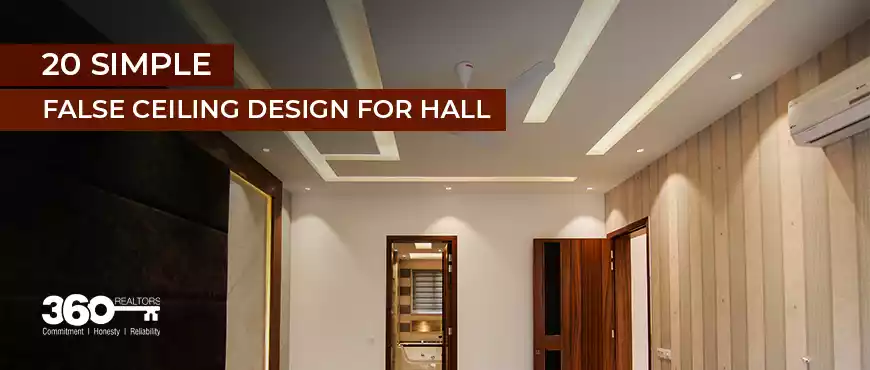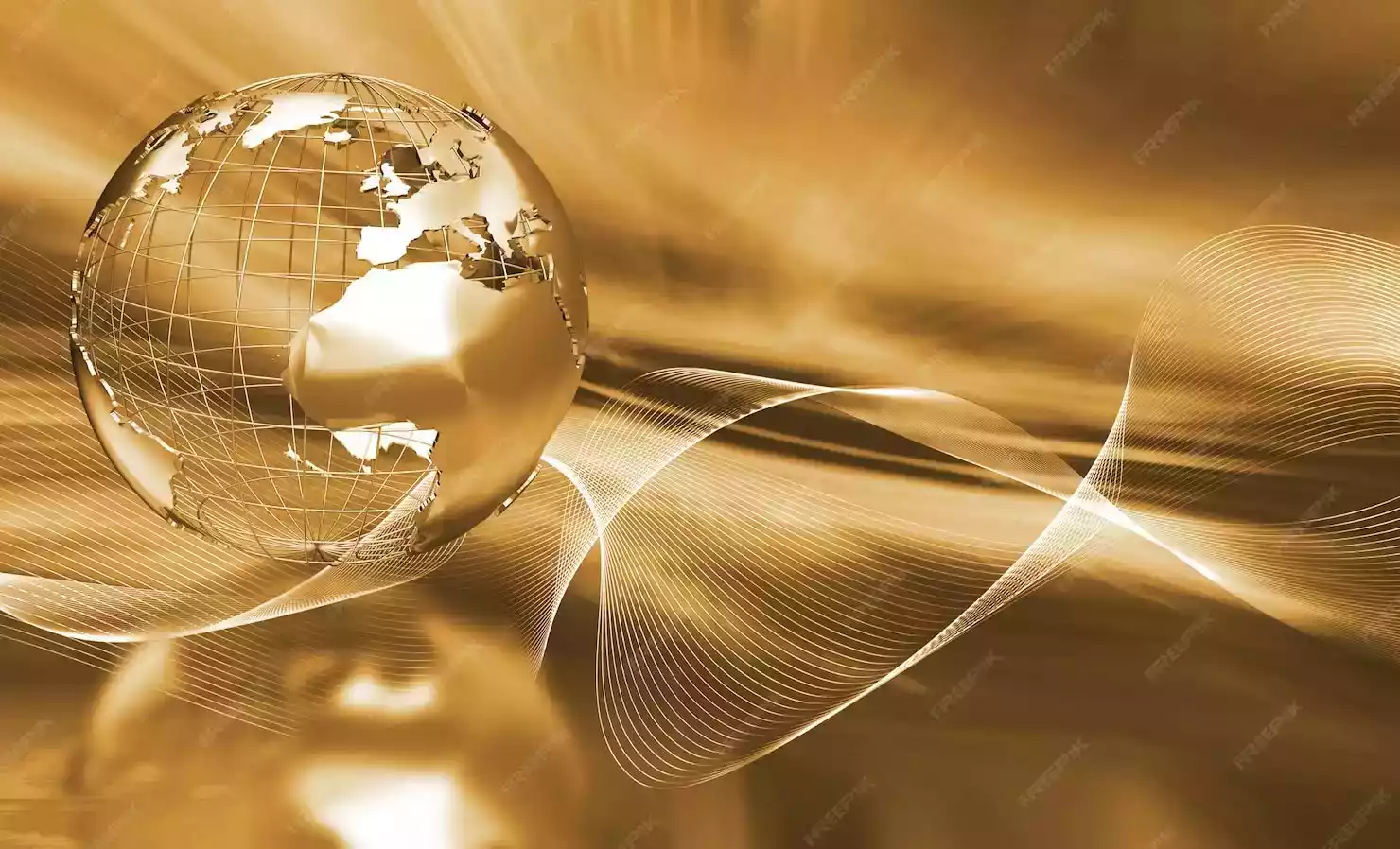If you are willing to purchase a new home in India and are exploring different options, you might come across the terms kutcha house and pucca house. Based on the nature of construction, houses can be divided into these two broad categories. As an informed property buyer, it’s imperative to know the differences between these two types of houses. This will help you make an informed decision and purchase the right type of property.
In this guide, we have explained the differences between kaccha house pakka house. Broadly speaking, a pakka house or pucca house is a construction designed to be solid and permanent. The walls and roofs of these houses are made from durable materials like burnt bricks, cement, concrete, stone, jackboard, or timber. On the other hand, kaccha houses are made of materials that aren’t permanent, like straw or leaves.
Now, let’s take a deeper look at both these classes of properties.
Kutcha houses means those where the walls and ceilings are made of mud, bamboo, grass, thatch, reed, leaves, straw, or unburnt bricks. These structures aren’t permanent like pucca houses that include buildings and flats or even semi pucca houses. Therefore, kaccha houses are temporary in nature and are usually found in rural areas. Even if they are seen in cities, they may serve as make-shift homes. Kaccha houses are vulnerable to harsh weather conditions and don’t come with modern amenities.
Pucca houses means, made of durable materials like burnt bricks, cement, concrete, and stone tend to be permanent. These houses are designed to withstand adverse weather conditions and offer a higher standard of living. The roofs of pucca houses may be made of tiles, asbestos cement sheets, galvanised corrugated iron (GCI) sheets, reinforced cement concrete, reinforced brick concrete, or timber.
Pucca house meaning also come with modern amenities and offer a better infrastructure for the residents. These facilities include electricity, proper sanitization, and water supply, and other facilities to ensure the well-being of the residents.
Considering the economic stature of Indian residents, pucca houses are associated with the more affluent masses.
Goa recorded the highest percentage of pucca houses as per the records of 2011, at 76%. On the other hand, Orissa, at 29.5%, had the least number of pucca houses.
Census 2011 also revealed that the highest number of dilapidated houses were located in West Bengal, while Goa had the lowest number of such homes. The Census also featured semi pucca houses, pucca houses, and kutcha houses. The two large categories of kutcha and semi pucca houses accounted for 48% of the properties.
However, rural and urban areas showed a gnawing difference. In pucca houses, the visible difference was 33%, while there was a 20% difference in semi-pucca houses.
Also Read | Condo Vs Townhouse
Check out the different types of kutcha houses in India. These houses have been categorized based on the materials used. However, one of the risks of kutcha or semi-pucca houses is their susceptibility to floors, earthquakes, cyclones, and other calamities. Besides, the security challenge in these homes continues to be an issue.
Here are the common materials used to make kutcha houses.
• Bamboos
• Unburnt bricks
• Mud
• Grass
• Thatch
• Reeds
• Loosely packed stones
The lack of proper amenities in kutcha houses like uninterrupted electricity, 24/7 water supply, toilets, and baths is one of the drawbacks of these homes. Most of these homes don’t have gas connections in their kitchens.
Now, let’s take a look at the key differences between kutcha house and pucca house in India.
|
Differences
|
Kutcha house
|
Pucca house
|
|
Material used
|
Commonly, kutcha houses are made of materials like straw, mud, stones, or wood.
|
Pucca houses are made of solid materials like bricks, iron, cement, concrete, and steel.
|
|
Economic stature
|
Usually, kutcha houses belong to financially backward sections of the economy since constructing these houses involves lower cost
|
Pucca houses belong to owners above the poverty line. These houses may cost several lakhs or crores and are owned by affluent individuals.
|
|
Structure
|
In kutcha houses, the structure is unstable and can easily get damaged during natural disasters.
|
The word pucca itself stands for permanent or stable. Since they are made of concrete or strong metals, they don’t sustain damage easily.
|
|
Purposes
|
Kutcha houses are built for makeshift accommodations, or are used as homes in rural areas.
|
Permanent houses are meant to last long, and serve as an investment
|
|
Amenities
|
The amenities in kutcha houses are very basic.
|
Pucca houses come with lots of lifestyle and entertainment amenities, and the range of such facilities depends on the price of these properties
|
|
Room demarcations
|
Room demarcations may not be available in kaccha houses
|
In pucca houses, rooms are properly demarked and they come with hallways, bedrooms, living rooms, baths, and kitchens.
|
Those residing in rural areas in kutcha houses enjoy several advantages of kutcha houses. Check out the benefits of these houses.
Strong, Durable, and Waterproof
Kaccha houses made of bricks and mud are sturdy and long-lasting. Once they are stabilized, the flooring and walls of these houses last long. The mud-brick combination keeps these houses intact for several decades. Although they stand the risk of collapse due to floods and earthquakes, they last fairly long. However, during wet seasons, they might turn problematic since these houses are made of mud.
Proper construction of kaccha houses makes them durable. For instance, these houses contain stabilizers like grain fiber, straw, gypsum, and agricultural runoff. The use of such materials makes these houses durable. With proper maintenance, they deteriorate very slowly and last for several years.
Recyclable
One of the key benefits of kutcha houses is that they are recyclable. This falls in line with the concept of sustainable living. Mud houses were the tradition for centuries before the inception of pucca houses. Even when these houses are destroyed, they can be used again or recycled. The materials used to make kutcha houses are recyclable, and mud can be reintroduced to nature easily. Since kutcha houses are made of eco-friendly materials, homeowners can drastically control their costs.
Carbon Footprint
Building mud houses involves lower environmental impact. Globally, the cement industry results in around 8% of the emissions of carbon dioxide. With pucca houses using cement extensively as a construction material, the carbon footprint associated with building these homes is relatively large. On the other hand, mud homes have a low impact on the environment since the material can be recycled and is extracted directly from the earth. Building mud homes does not involve the release of carbon dioxide.
Kutcha houses have several advantages and these homes are preferred by owners in rural areas. These include:
• Cost-Effectiveness: Kutcha houses are more cost-effective since building these properties requires limited resources. Besides, it is more affordable to repair these properties.
• Natural Insulation: Since natural materials are used to construct kutcha houses, they offer a good thermal insulation. During the colder months, the interiors remain warm, while people enjoy cooler living environments during summers.
• Biodegradable: These homes are made from biodegradable or eco-friendly materials like straw, clay, and mud. They do not pollute the environment like artificial building materials, chemical paints, and plastics.
Have a look at the disadvantages of kutcha houses.
• Unstable: When you compare kaccha house pakka house, the latter turns out to be more stable. Floods, storms, and natural disasters can damage kutcha houses easily.
• Frequent Repairs: The materials used in kutcha houses can wear off easily. This explains why these houses need more frequent repairs. For instance, the thatched roofs or other parts of these houses need to be replaced from time to time.
Also Read | Condo vs Apartment
Pucca houses, known for their sturdiness and long-lasting nature, come with several advantages. This makes them a popular choice in urban and semi-urban areas. Here are some benefits of pucca houses:
Strong, Durable, and Weather-Resistant
The materials used in manufacturing pucca houses are more robust. Generally, these include cement, concrete, steel, bricks, etc. This makes them highly durable and capable of withstanding adverse weather conditions. The strong materials ensure that the structure remains protected even during heavy rains, strong winds, and other natural calamities. Pucca houses last longer than kutcha houses. With proper construction and maintenance, they can last several decades. Also, these houses require minimal maintenance. Those living in pucca houses enjoy a sense of security and peace of mind.
Low Maintenance
One of the key advantages of pucca houses is that they require low maintenance. The materials used to make these houses are durable and they remain in good condition for extended periods. Different parts of kutcha houses may require frequent replacements and repairs. However, in pucca houses, maintenance has to be carried out occasionally to keep the property in good shape. This significantly reduces the long-term costs associated with upkeep.
Higher Property Value
The resale value of pucca houses is higher than that of kutcha houses. They are permanent and durable in nature, and come with lots of modern facilities and amenities. Thus, they appeal to potential buyers, making them a great asset for investment. Over time, pucca houses undergo property value appreciation, particularly when you buy them in the right location. Investors consider pucca houses to be a significant asset category in real estate since they can also enjoy rental income over a prolonged period of time. Flats, for instance, are a common pucca house example that investors tend to buy to diversify their assets.
Have a look at the key advantages of pucca houses.
• Enhanced Safety and Security: Pucca houses are known for their solid construction. This ensures better protection against theft, fire, and other hazards compared to kutcha houses. The residents enjoy better safety and well-being in these homes.
• Modern Amenities: Pucca houses come with modern amenities like proper plumbing, sanitation, and electrical systems. This enhances the quality of lifestyle for the residents, providing them with comfort and convenience.
• Aesthetic Appeal: Pucca houses can be designed and constructed in various architectural styles. This offers a better aesthetic appeal and enhances the overall appearance of the home. Since modern materials and techniques are used in the construction process, the designs are more creative and visually appealing.
Although pucca houses come with several advantages, they still have some drawbacks. Have a look at these disadvantages in this section.
• Higher Construction costs: Building a pucca house involves significant investment. The cost of materials and labour is higher in this type of property construction. With individuals with limited financial resources, building a pucca house can be challenging.
• Environmental impact: The construction of pucca houses often involves the use of non-renewable resources and energy-intensive processes. This leads to a higher carbon footprint. This environmental impact is a concern for those seeking sustainable living options.
• Time-consuming process: It may take several months to construct a pucca house. Thus, constructing a pucca house can be a time-intensive process. The process requires extensive planning and execution. Those who need an immediate housing solution might not find it to be a feasible option.
Also read | 20 Best Normal House Front Elevation Designs
In this section, we are going to discuss certain terms that property buyers should be aware of.
Semi-Pucca Houses
Semi-pucca houses have walls made of strong materials, but the roof of these homes isn’t made of concrete or other durable materials traditionally used in pucca houses. In semi-pucca houses, the roof may be made of hay or straw. On the other hand, the exterior walls are strong and made of concrete. This makes semi-pucca houses weaker than pucca houses but stronger than kutcha houses. Compared to kutcha houses, these properties also come with a higher number of amenities. Overall, in terms of durability and comfort, they don’t match the standards of pucca houses.
Independent Houses
Independent houses are those featuring a separate entrance and structure. The inhabitants enjoy self-contained arrangements like kitchens, living rooms, latrines, bathrooms, verandas, and store rooms. Independent houses are pucca in nature and are built of sturdy materials to enhance their durability. Generally, these houses are made of iron, bricks, and cement.
Stilt Houses
Stilt houses belong to the kutcha house category. They are developed on stilts or piles on the surface of water bodies or soil. Usually, they are made of materials used in kaccha houses, such as bamboo. The roofs of these houses are slanting which allows water to run off. Usually, stilt houses are built in areas prone to flood as they protect the properties against damage. These houses come with efficient drainage systems and they are mounted on stilts to allow the excess water to drain out of the interior of the house. Usually, stilt houses are found in semi-urban or rural areas in the country.
Now that you know the differences between kutcha house and pucca house, you can confidently proceed to your purchase. The choice between these two broad categories of property in India depends on several aspects like financial stature, lifestyle preferences, and environmental awareness. Kaccha houses, with their cost-effectiveness, natural insulation, and eco-friendly materials, offer a sustainable and affordable option for rural communities. However, they are vulnerable to natural disasters and may require frequent repairs.
On the other hand, pakka houses are durable and modern. They offer better living standards and security in the long-term. Thus, pucca houses are a preferred choice in semi-urban and urban areas. Although these properties involve higher construction costs and environmental impact, residents benefit in terms of property value increment and low maintenance.
As the country continues to develop, urban areas continue to witness the development of a higher number of pakka houses. Naturally, investors opt for these durable properties that promise better ROI, serving as a valuable asset class in India.
FAQs
Typically, kaccha houses are made of materials like straw, bamboo, mud, etc. However, these materials are susceptible to adverse weather conditions and that’s why these homes need frequent repairs and replacements.
Those willing to live in a place for a relatively shorter timespan go for kutcha houses. Also, people unable to afford a pucca house live in kaccha houses.
Although kutcha houses are found in Indian cities, they are used as makeshift homes in the peripheral areas. They are hardly used for dwelling permanently in the city.
Yes, you can get PMAY Gramin offer or kutcha houses. This scheme has been developed to help those who fail to afford a property on their own and are currently residing in a kaccha house with no access to basic amenities.






